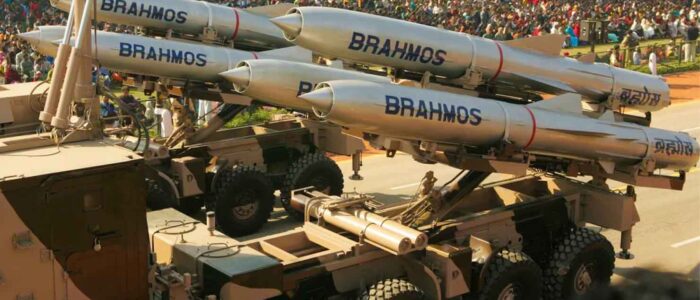In 2015, the Indian Navy commissioned a new naval base INS Sardar Patel in Porbandar, Gujarat, to strengthen the security of the frontline maritime state. During its launch ceremony, the then Chief of Naval Staff (CNS) Admiral Robin K. Dhowan outlined that the base would also provide operational support to naval assets deployed in the region, apart from logistics facilities.
INS Sardar Patel may be serving as a logistics support facility for Western Naval Command. But, an analysis of open-source satellite imagery shared by observers at PAK-IMINT suggests that the base may also be managing a storage depot for BrahMos missiles.
Construction of the BrahMos missile storage complex began in the latter half of 2017, during the tenure of Dhowan’s successor Admiral Sunil Lamba and was completed by mid-2020, under Lamba’s successor Admiral Karambir Singh. The complex consists of three linear magazines of eight storage bays each, totalling 24 bays. At the bare minimum, this complex can store no less than 24 missiles at any given time.
The storage complex also has an integration and storage building adjacent to it. It is situated in Dharampur village of Porbandar, almost 8km from INS Sardar Patel.

Image Source: PAK-IMINT
If we assume the stored missiles to have the standard 300km range, a launch from waters near Pakistan’s maritime boundaries could easily take out Karachi, Hyderabad, and other important garrisons in Sindh. Vital installations include oil terminals in Sindh, three bases in Pakistan Air Force’s Southern Air Command (Masroor, Faisal and Bholari), naval dockyards and bases, and the headquarters of the Pakistan Army’s 5 Corps.

Image Source: PAK-IMINT
If the Indian Navy launches extended range BrahMos missiles from the same waters off Gujarat, these could also target sensitive installations in Balochistan, thus increasing the targeting canvas for Western Naval Command.
Earlier this year, the Pakistan Armed Forces circulated a concept paper on Strategic Petroleum Reserves (SPR) which proposed setting up an underground SPR facility in Gwadar (Balochistan) linked with pipelines to Karachi (Sindh) and Mehmood Kot (Punjab). Joint Staff Headquarters’ rationale for an underground facility was to protect against terrorist attacks and airstrikes.
With the revelation of INS Sardar Patel having a BrahMos storage complex nearby, Pakistan’s defence planners may need to review their proposed layout of the underground SPR network. Augmenting existing air defence systems is not likely to prove helpful against the stealthy BrahMos. The Pakistan Navy will have to step up its maritime patrols to pre-empt the movement of Indian Navy vessels and acquire real-time satellite imagery on INS Dwarka and INS Sardar Patel.
Yet, there are no credible reports about Pakistan having access to real-time satellite imagery for military purposes (adversary troop tracking, infrastructure development monitoring, fleet tracking etc.). Few reports about China’s BeiDou providing navigational support for Pakistan’s missiles, even if true, are separate from military intelligence that is acquired from spy satellites.
What this recent open-source satellite imagery confirms is that INS Sardar Patel is indeed not just a logistics and maintenance support facility for the Indian Navy but also operational support.
